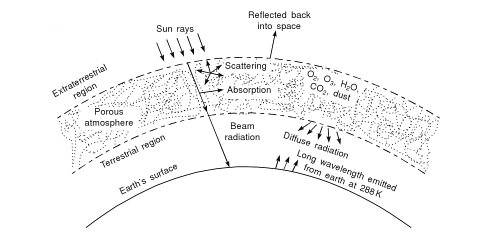Terrestrial Radiation is the thermal radiation of the earth’s surface. Since the surface of the earth has a comparatively low temperature, it radiates electromagnetic waves with wavelengths of 380 microns, which fall into the infrared portion of the spectrum, which is invisible to the eye. The surface of the earth cools down because of its intrinsic radiation. The flow of intrinsic radiation of the surface of the earth is directed upward and is absorbed almost entirely by the atmosphere, thus heating it. The atmosphere, in turn, sends counter radiation toward the surface of the earth (atmospheric counter-radiation) at approximately the same wavelengths, which partially compensates for the loss of heat by the surface of the earth as a result of its intrinsic radiation. The difference between the radiation of the surface of the earth and the counter-radiation is called the effective radiation. On clear nights the counter-radiation decreases and the effective radiation increases; therefore, the surface of the earth is cooled abruptly and the lower layers of the air are cooled by it. In the process fog or dew may occur, and in the spring and fall, there may be frosts. On cloudy nights, on the other hand, the counter-radiation increases because of the radiation of the clouds, and the effective radiation and cooling of the surface of the earth are reduced. During the day the surface of the earth also receives solar radiation in addition to the counter-radiation. Together they exceed terrestrial radiation for most of the day (during the warm part of the year in moderate latitudes), and the surface of the earth heats up. Terrestrial radiation is one of the most important factors determining the thermal conditions of the surface of the earth and of the atmosphere.

Downward infrared (terrestrial) irradiance – All matter with a temperature greater than 0 K (Kelvin) emits electromagnetic energy; the amount of energy and wavelengths at which the energy is emitted are dependent on the temperature of the body. The higher the temperature of the body, the greater the magnitude of the energy radiated and the shorter the wavelengths at which that peak energy is radiated. A body will radiate energy over a range of wavelengths, called the body’s radiation spectrum (a subset of the complete electromagnetic spectrum). Most of the Sun’s spectrum lies in the wavelength range of 0.25 – 4.0 μm (1 μm (micrometre)= 10-6 m), the so-called short wave range. Downward infrared irradiance is a measurement of the irradiance arriving on a horizontal plane at the Earth’s surface, for wavelengths in the range 4 – 100 μm (the wavelength emitted by atmospheric gases and aerosols). It is related to a `representative (or effective radiative) temperature’ of the Earth’s atmosphere by the Stefan-Boltzmann Law
E = σ T4
Where: E = irradiance measured [W/m2], σ = Stefan-Boltzmann constant [5.67 x 10-8 W/m2/K4,
T = representative atmospheric temperature [K].
Consequently, this quantity will continue to have a positive value, even at night time. It can be measured using an Eppley PIR pyrgeometer. As in the case of diffuse solar irradiance measurement, it is required that this instrument is shaded from the direct beam of the Sun during the day, since the Sun’s beam can heat the pyrgeometer dome and contribute to error in the measurement. Accordingly, the pyrgeometer is mounted on a tracker. The ‘representative temperature’ is dependent on a number of factors, but typically larger values are recorded when middle to low level clouds cover the sky than those recorded during clear sky episodes.

